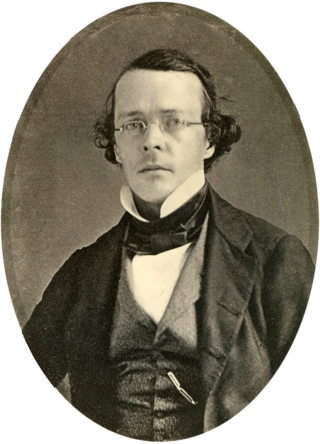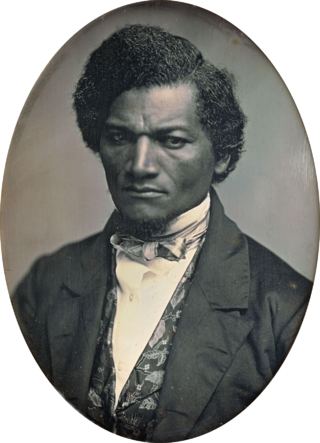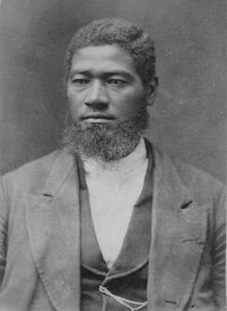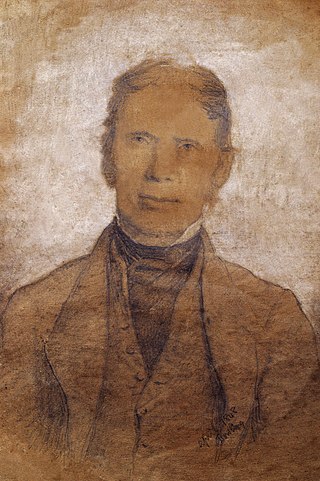
Frederick Douglass was an American social reformer, abolitionist, orator, writer, and statesman. He became the most important leader of the movement for African-American civil rights in the 19th century.

Abolitionism, or the abolitionist movement, is the movement to end slavery and liberate slaves around the world.

William Lloyd Garrison was an American abolitionist, journalist, and social reformer. He is best known for his widely read anti-slavery newspaper The Liberator, which Garrison founded in 1831 and published in Boston until slavery in the United States was abolished by the Thirteenth Amendment in 1865.

The American Colonization Society (ACS), initially the Society for the Colonization of Free People of Color of America, was an American organization founded in 1816 by Robert Finley to encourage and support the repatriation of freeborn people of color and emancipated slaves to the continent of Africa. It was modeled on an earlier British colonization in Africa, which had sought to resettle London's "black poor".

The American Anti-Slavery Society was an abolitionist society founded by William Lloyd Garrison and Arthur Tappan. Frederick Douglass, an escaped slave, had become a prominent abolitionist and was a key leader of this society, who often spoke at its meetings. William Wells Brown, also a freedman, also often spoke at meetings. By 1838, the society had 1,350 local chapters with around 250,000 members.

Henry Highland Garnet was an American abolitionist, minister, educator and orator. Having escaped as a child from slavery in Maryland with his family, he grew up in New York City. He was educated at the African Free School and other institutions, and became an advocate of militant abolitionism. He became a minister and based his drive for abolitionism in religion.

The Liberator (1831–1865) was a weekly abolitionist newspaper, printed and published in Boston by William Lloyd Garrison and, through 1839, by Isaac Knapp. Religious rather than political, it appealed to the moral conscience of its readers, urging them to demand immediate freeing of the slaves ("immediatism"). It also promoted women's rights, an issue that split the American abolitionist movement. Despite its modest circulation of 3,000, it had prominent and influential readers, including all the abolitionist leaders, among them Frederick Douglass, Beriah Green, Arthur and Lewis Tappan, and Alfred Niger. It frequently printed or reprinted letters, reports, sermons, and news stories relating to American slavery, becoming a sort of community bulletin board for the new abolitionist movement that Garrison helped foster.
The Genius of Universal Emancipation was an abolitionist newspaper founded by Benjamin Lundy in 1821, in Mount Pleasant, Ohio.

The National Anti-Slavery Standard was the official weekly newspaper of the American Anti-Slavery Society, established in 1840 under the editorship of Lydia Maria Child and David Lee Child. The paper published continuously until the ratification of the Fifteenth Amendment to the United States Constitution in 1870. Its motto was "Without Concealment—Without Compromise." It not only implies suffrage rights for colored males, but also women's suffrage as well. It contained Volume I, number 1, June 11, 1840 through volume XXX, number 50, April 16, 1870.

George Donisthorpe Thompson was a British anti-slavery orator and activist who toured giving lectures and worked for legislation while serving as a Member of Parliament. He was arguably one of the most important abolitionists and human rights lecturers in the United Kingdom and the United States.

William Cooper Nell was an American abolitionist, journalist, publisher, author, and civil servant of Boston, Massachusetts, who worked for the integration of schools and public facilities in the state. Writing for abolitionist newspapers The Liberator and The North Star, he helped publicize the anti-slavery cause. He published the North Star from 1847 to 18xx, moving temporarily to Rochester, New York.

In the United States, abolitionism, the movement that sought to end slavery in the country, was active from the late colonial era until the American Civil War, the end of which brought about the abolition of American slavery, except as punishment for a crime, through the Thirteenth Amendment to the United States Constitution.

Isaac Knapp was an American abolitionist printer, publisher, and bookseller in Boston, Massachusetts. He is remembered primarily for his collaboration with William Lloyd Garrison in printing and publishing The Liberator newspaper.

The Edinburgh Ladies' Emancipation Society was a leading abolitionist group based in Edinburgh, Scotland, in the nineteenth century. The women associated with the organisation are considered "heroines" and the impact of these abolitionist organisations for women are thought to have had a notional impact.

"What to the Slave Is the Fourth of July?" was a speech delivered by Frederick Douglass on July 5, 1852, at Corinthian Hall in Rochester, New York, at a meeting organized by the Rochester Ladies' Anti-Slavery Society. In the address, Douglass states that positive statements about perceived American values, such as liberty, citizenship, and freedom, were an offense to the enslaved population of the United States because they lacked those rights. Douglass referred not only to the captivity of enslaved people, but to the merciless exploitation and the cruelty and torture that slaves were subjected to in the United States.

William Gustavus Allen was an African-American academic, intellectual, and lecturer. For a time he co-edited The National Watchman, an abolitionist newspaper. While studying law in Boston he lectured widely on abolition, equality, and integration. He was then appointed a professor of rhetoric and Greek at New-York Central College, the second African-American college professor in the United States. He saw himself as an academic and intellectual.

The Fugitive Slave Convention was held in Cazenovia, New York, on August 21 and 22, 1850. It was a fugitive slave meeting, the biggest ever held in the United States. Madison County, New York, was the abolition headquarters of the country, because of philanthropist and activist Gerrit Smith, who lived in neighboring Peterboro, New York, and called the meeting "in behalf of the New York State Vigilance Committee." Hostile newspaper reports refer to the meeting as "Gerrit Smith's Convention". Nearly fifty fugitives attended—the largest gathering of fugitive slaves in the nation's history.

John Murray (1787–1849) was an abolitionist and social activist who served as Corresponding Secretary of the Glasgow Emancipation Society.
The National Convention of Colored Citizens was held August 15–19, 1843 at the Park Presbyterian Church in Buffalo, New York. Similar to previous colored conventions, the convention of 1843 was an assembly for African American citizens to discuss the organized efforts of the anti-slavery movement. The convention included individuals and delegates from various states and cities. Henry Highland Garnet and Samuel H. Davis delivered key speeches. Delegates deliberated courses of action and voted upon resolutions to further anti-slavery efforts and to help African Americans.

In the District of Columbia, the slave trade was legal from its creation until it was outlawed as part of the Compromise of 1850. That restrictions on slavery in the District were probably coming was a major factor in the retrocession of the Virginia part of the District back to Virginia in 1847. Thus the large slave-trading businesses in Alexandria, such as Franklin & Armfield, could continue their operations in Virginia, where slavery was more secure.




















